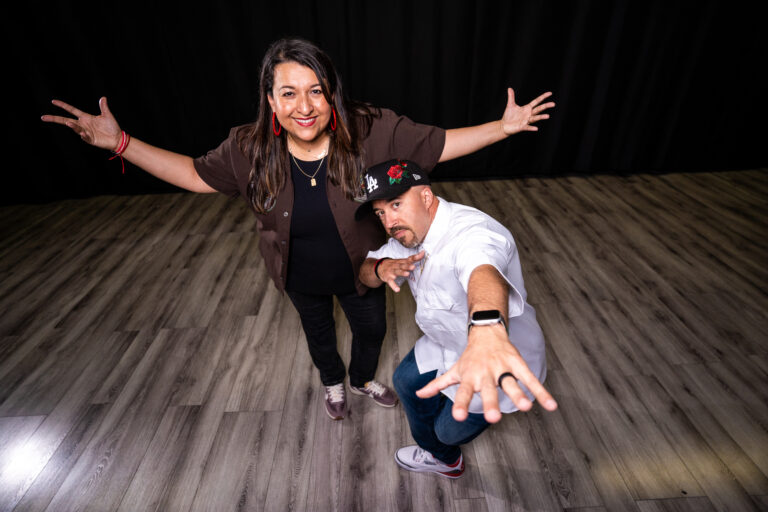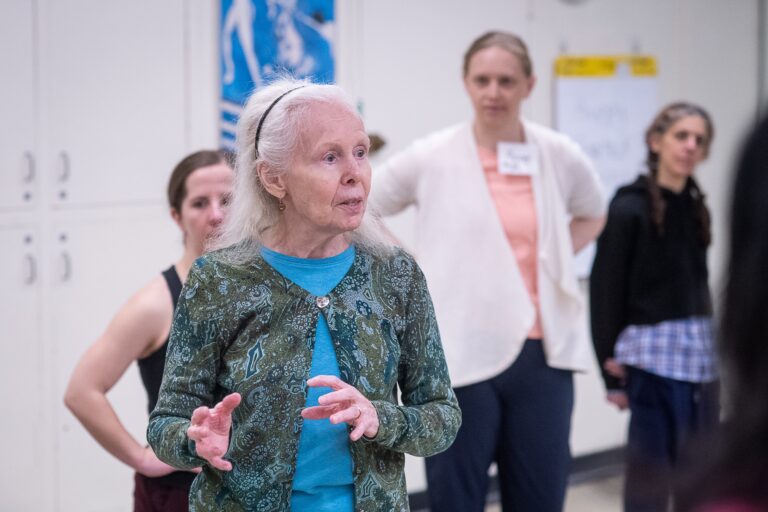Harlequin Woodspring with hardwood, Ballet Austin studiosOpening your own studio requires not only a large space but a hefty investment in equipment—floors, barres, mirrors and more. The options can be overwhelming; the key is to first consider your space and class offerings.
For instance, if you plan to offer ballet, pointe, tap, jazz and barre workouts for classes of 15 to 25 students, you will likely need one larger studio of about 1,400 to 1,500 square feet and one smaller studio of about 900 to 1,000 square feet. The larger studio can be dedicated to ballet and fitness, with permanent bracketed barres, while the other can be a multi-use room for younger students, including portable barres and double-sided mirrors for viewing.
We consulted with studio owners, manufacturers and suppliers to learn what you can expect to spend. Note: All estimates are based on a 1,500-square-foot studio and do not include installation.
Stagestep Flooring product, Timestep, can be installed as a temporary, semi-permanent or permanent solution.
“Maintenance of your floor is key. Make a schedule to dry-mop every day, wet-mop every week and give a full cleaning twice a year during your studio breaks. With good maintenance, floors can last you 10 to 15 years.”
—Randy Swartz, Stagestep Flooring SolutionsFloors
Floors come in permanent, semi-permanent and portable options with both surfaces and subfloors. While manufacturers tend to recommend vinyl (often called marley) surfaces for studios, hardwood floors are a time-honored tradition—and are the preferred choice for tap and ballroom. Hardwood, while durable, costs more both in materials and installation. It also requires greater upkeep, such as frequent refinishing to prevent splintering.
Permanent floors are the best choice when you own your space. They last the longest and require less maintenance because the seams are welded together to prevent water damage. Typically, the floor surface and the subfloor, or “sprung” layer, are sold as a package. Plan $10–$13 per square foot.
Expect to spend: $15,000–$19,500, including both subfloor and vinyl or hardwood top layer.
If you’re renting, semi-permanent floors make most sense. Vinyl surface floors run $2–$6 per square foot. The subfloor component is sold separately.
Expect to spend: $3,000–$9,000
Portable floors generally work best as traveling floors. Expect to spend: Similar in price to a semi-permanent floor and subfloor.
For your dancers’ safety and health, you need a sprung floor, created by installing a subfloor that provides a layer between the dance surface and the concrete below. Plan $3–$15 per square foot.
Expect to spend: $4,500–$22,500
“Portable barres allow students to view themselves full-body facing the mirror to make sure they are ‘on their leg’ and positioning correctly.”
—Finis Jhung, Ultimate BarreBarres
Permanent barres require brackets, and the type depends on the usage; for heavy-duty work, like ballet classes, consider brackets that wrap fully around your barre. Be sure that your building has the proper wall backing to support brackets, or you will have difficulty securing them. Permanent barres range in price from $100–$400, depending on size and durability.
Expect to spend: About $1,000 for barres on three sides of the studio.
Aluminum or wood? Aluminum barres are lightweight and do not corrode; wooden barres have a smooth feel but require more maintenance and cleaning.
Portable barres can range from cheap to very durable that will last for several decades. If storage and space are issues, consider buying barres with rotatable feet that can lie flat against the wall. Portable barres are ideal for sharing among multiple rooms. They run $200–$400 per barre for the best quality.
Expect to spend: $1,000, or roughly the same as for permanent barres.
Note: Both permanent and portable barres come in adjustable sizes and heights; adjustable brackets for wall installations will be more expensive.
Mirrors
The larger the mirror, the better the price. At least one studio wall will need a floor-to-ceiling mirror, about eight feet high.
Expect to spend: Three to five 6′ x 8′ mirrors, $1,500–$3,000.
Observation windows: Two-way mirrors are great for allowing parents to observe students. These can be set into the walls and cost about $350 for a 2′ x 4′.
Makers and Suppliers
Dance Equipment International
danceequipmentintl.com
En Pointe Enterprises
en-pointe.com
Entertainment Flooring Systems
flooradvice.com
Finis Jhung
finisjhung.com
Gerstung
gerstung.us
Harlequin Floors
harlequinfloors.com
O’Mara Sprung Floors
sprungfloors.com
Stagestep Flooring Solutions
stagestep.com
A professionally installed sprung dance floor is a lasting investment.To Buy or DIY?
When Donna Aravena of the Seven Star School of Performing Arts in Brewster, New York, went to dinner one night at a local Applebee’s, she noticed price tags on the furniture. “I needed seating for my waiting area,” she says, so she asked if the booths were for sale. Turned out, the restaurant was going out of business, and the booths were going in the garbage. Aravena had found a free solution to her seating problem.
The cost of building a dance studio from scratch can add up quickly. Yet a creative owner can always find ways to trim. And… DIY can be fun! Some tasks lend themselves to a group effort. Having a painting party or building your cubbies will shave down expenses and can help parents and teachers bond. If you have a parent who can make the curtains for your changing areas, so much the better.
But some tasks need a professional’s expertise to ensure proper installation.
Floors. Buying a sprung dance floor from an established manufacturer and having it professionally installed will ensure its durability and keep your students safe from injuries. Higher-quality sprung floors require a fully constructed subfloor—the sprung layer—that takes time and skill to build. It makes sense to use a professional. If your budget is tight, most major floormakers offer cheaper self-install options.
Mirrors. When Suzanne Blake Gerety of Kathy Blake Dance Studios in Amherst, New Hampshire, was ready to hang her mirrors, she had them installed by a glass/mirror professional. Hanging can be tricky. Mirrors must be properly mounted into tracks on walls that can support their weight. “Find out if the company you’re using has done work in gyms or other studios,” Gerety advises. “They should know the type of wear and tear that happens.” If you do decide to hang mirrors yourself, make sure you have enough help to handle the positioning. When Denise Schindler of Blanchard Dance Center in Kenner, Louisiana, first opened her school, she had four parents to help her install the mirrors, which took around five hours.
Barres. Buying a good-quality pre-made barre will guarantee you and your students have exactly what you need, sans splinters. Having those barres mounted professionally will ensure that they are secure. But you can mount your own, providing you level them accurately and anchor them securely.
—Betsy Farber
Photos courtesy of Harlequin, Stagestep (3), LeapnLearn



